Try Default

See how revenue teams automate revenue operations with Default.

Key Takeaways
- Default – Best for inbound orchestration: automates enrichment, routing, and scheduling to cut delays and accelerate pipeline.
- ZoomInfo – Best for contact data: verified global database with deep filtering for outbound precision.
- Waalaxy – Best for LinkedIn automation: affordable sequencing across LinkedIn and email for SDRs at scale.
- Hunter.io – Best free option: quick domain-level email finder and verifier for lean teams.
Sales prospecting is the first step in revenue generation — but in 2025, it’s also one of the hardest to get right. Teams are under pressure to hit higher targets while competing in crowded inboxes and dealing with more demanding buyers. Without the right tools, reps spend hours chasing low-fit leads, cleaning up bad data, or manually routing prospects that should have been engaged instantly.
This guide focuses on what actually works.
We’ve selected 15 prospecting tools that address real GTM challenges — from instant LinkedIn capture to fully automated inbound orchestration. Whether you’re a RevOps leader designing inbound workflows, an SDR building outbound campaigns, or a founder running sales yourself, you’ll find software built to match your motion.
First, check the comparison table for a quick scan of all options. Then, dive into the breakdowns of each tool’s strengths, trade-offs, and pricing.
Sales prospecting tools comparison (2025)
What is sales prospecting?
Sales prospecting is identifying and connecting with potential buyers who match your ideal customer profile — and doing it efficiently enough to keep your pipeline full of high-conversion opportunities. It’s the first and most critical step in revenue generation.
The best prospecting blends enrichment, segmentation, and targeted outreach so reps spend time on high-intent accounts, not dead ends. Done right, it drives faster deal cycles. Done wrong, it drains hours and bloats your CRM with unqualified leads.
Default: best sales prospecting tool for inbound GTM teams

Default is built for one job: turning inbound interest into qualified pipeline automatically. Instead of juggling multiple point solutions, GTM teams use Default as a single control center for enrichment, deduplication, routing, and scheduling.
For RevOps and demand gen leaders, that means fewer tools to manage, no manual handoffs, and response times measured in seconds — not minutes or hours.
Key features
Visual workflow builder
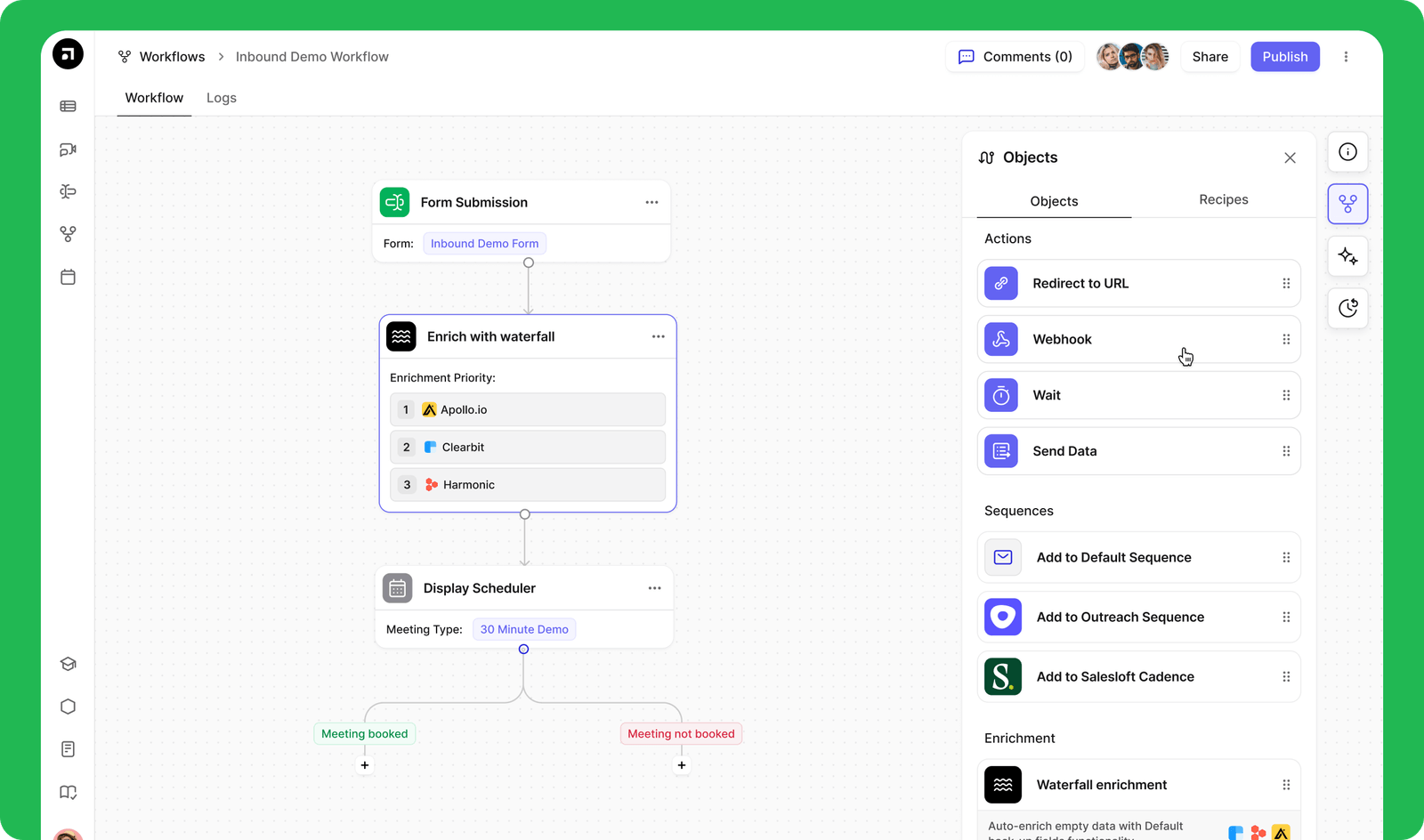
Build and launch inbound routing flows in minutes with drag-and-drop logic. Trigger actions based on form fills, enrichment results, CRM match, or website behavior to get qualified leads to reps instantly.
Automated lead enrichment
Use enrichment waterfalls to fill missing firmographic and contact fields, de-dupe against your CRM, and verify accuracy before routing.
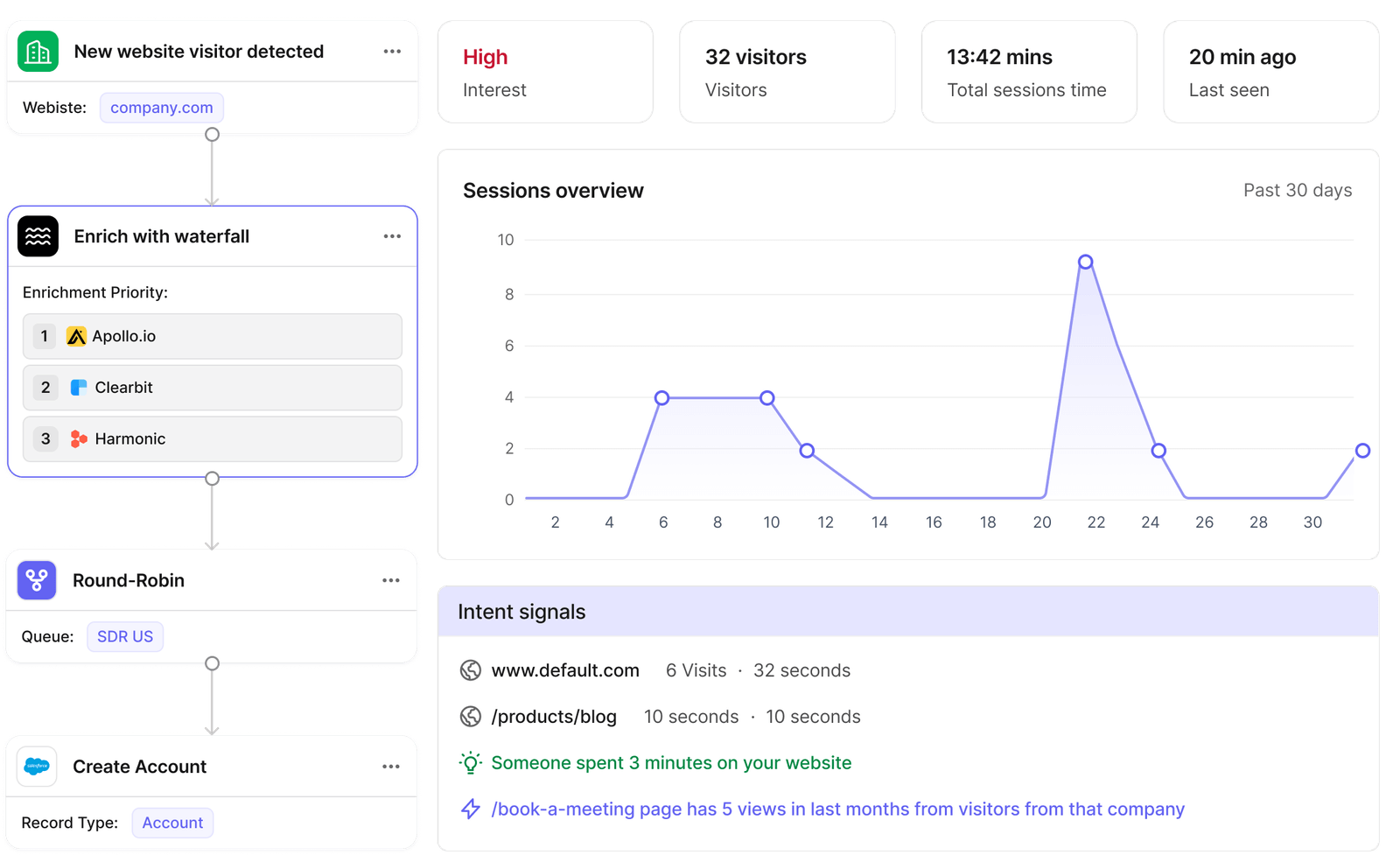
Native scheduling + routing
Auto-assign meetings to the right rep based on territory, ownership, or availability, while logging every interaction in your CRM.

Pricing
Note: Default's pricing includes a platform fee and a license fee. Only users involved in meetings, CRM ownership, or workflows are billed; all editor seats are free.
Where Default shines
- Pipeline speed at scale – Real-time qualification and routing reduce lead response times from minutes to seconds.
- All-in-one orchestration – Combines lead enrichment, routing, scheduling, and CRM hygiene in a single platform.
- Zero-code deployment – Launch complete inbound workflows without engineering support.
Where Default falls short
- Outbound sequencing – Not designed for cold email or multichannel outbound automation.
Customer reviews
“Default has been very helpful in the collection of website visitors and turning them into inbound MQL's with enriched data. Default integrates directly with our CRM as well as our outreach toolkit, allowing for a seamless data flow and ensuring no leads slip through untouched.” - verified G2 reviewer
“As easy as copying & pasting a link to share with customers to book time with you whenever -- uploads directly to & automatically works around your Google Calendar (or whatever calendar platform you use)” - Kaylee M., verified G2 reviewer
Who Default is best for
- RevOps teams scaling inbound workflows.
- Demand gen leaders prioritizing speed-to-lead.
ZoomInfo: best sales prospecting tool for verified contact data
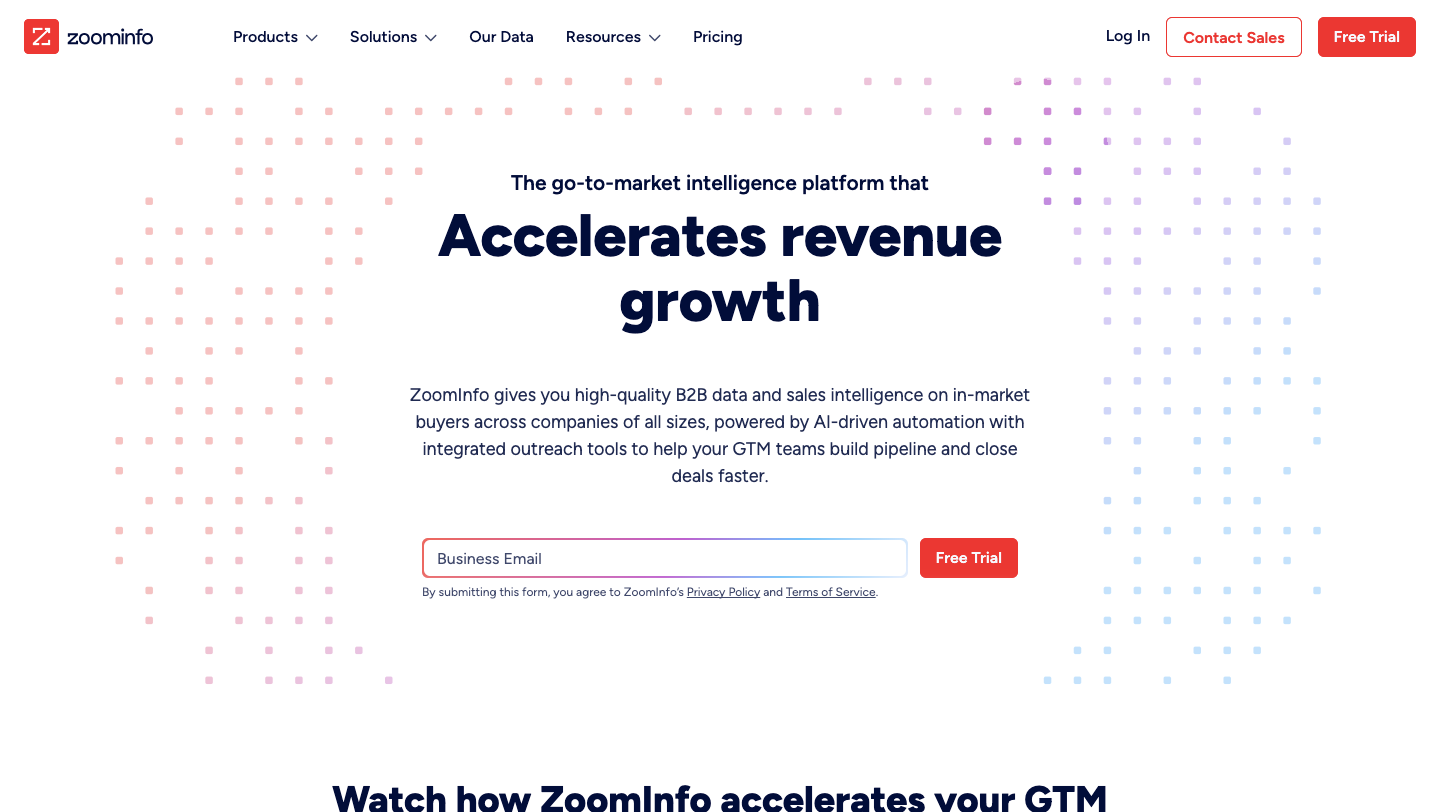
If you’ve ever run outbound at scale, you know how much hinges on the accuracy of your contact data. That’s the gap ZoomInfo fills — a massive database with direct dials and emails that outbound teams lean on when precision matters. The trade-off is cost, but for large campaigns, the coverage is hard to beat.
Key features
- Extensive contact database – 100M+ verified B2B records with job titles, phone numbers, emails, and company details.
- Buyer intent signals – Identify prospects actively researching your category and prioritize them by likelihood to convert.
- Native CRM integrations – Push enriched contacts directly into Salesforce, HubSpot, Outreach, or Salesloft.
Pricing
Where ZoomInfo shines
- Data accuracy at scale – Consistently high match rates for outbound campaigns.
- Advanced segmentation – Dozens of filters for precise targeting across job role, industry, intent, and tech stack.
Where ZoomInfo falls short
- High cost of entry – Pricing can be prohibitive for smaller or early-stage teams.
- Inbound overkill – Its depth of data may be unnecessary if inbound is your main GTM motion.
Customer reviews
“The intent signal were quite good. We used it a lot to track companies and saw some success. Data for emails and number for Europe wasn't that great.” - Amanda A., verified G2 reviewer
Who ZoomInfo is best for
- Outbound-focused sales teams running multi-touch ABM.
- GTM teams needing verified contact data at scale for cold outreach.
Waalaxy: best sales prospecting tool for LinkedIn outreach automation

LinkedIn outreach can be effective, but it’s rarely efficient at volume. Waalaxy tackles that problem by automating connection requests and basic sequences. It’s simple, affordable, and works well for early teams — but you’ll need other tools to cover enrichment or broader multichannel plays.
Key features
- LinkedIn + email sequences – Blend LinkedIn messages with automated email follow-ups to increase touchpoints.
- Smart inbox + CRM sync – Manage all LinkedIn replies in one dashboard and push qualified leads directly into your CRM.
- No-code campaign builder – Launch personalized campaigns in minutes using templates and trigger-based automation.
Pricing
Where Waalaxy shines
- Fast setup – Start campaigns within hours, no technical skills required.
- Budget-friendly scaling – Suited for teams running high-volume outreach without enterprise spend.
Where Waalaxy falls short
- LinkedIn-only – No native support for broader multichannel workflows.
- No built-in enrichment – Requires pairing with a separate tool to verify and enrich contact data.
Customer reviews
“Waalaxy makes it easy to run multi-channel LinkedIn and email campaigns at scale. I liked how fast I could launch outreach flows and how much manual work it saved. But, ran into frequent bugs and clunky sequences. Support was slow and some tactics (like upsells and surveys) felt pushy.” - verified G2 reviewer
Who Waalaxy is best for
- SDRs and founders automating LinkedIn prospecting on a budget.
- Early-stage teams testing outreach at volume before investing in full engagement platforms.
Hunter.io: best sales prospecting tool for lightweight email discovery

Sometimes all you need is a verified email to get started. Hunter.io keeps it that straightforward: find the right addresses, validate them, and move on. It’s fast and inexpensive, though it won’t give you the firmographics or lead scoring needed for more advanced targeting.
Key features
- Domain search – Instantly pull verified email addresses for any company.
- Email verifier – Validate addresses in bulk to cut bounce rates and protect sender reputation.
- Chrome extension – Capture verified emails while browsing LinkedIn or a company’s site.
Pricing
Where Hunter.io shines
- Speed and simplicity – Build verified email lists in minutes with zero learning curve.
- Low cost of entry – Accessible for small teams or solo operators.
Where Hunter.io falls short
- No enrichment data – Lacks firmographic or technographic details for qualification.
- No sequencing – Must be paired with a separate outreach platform.
Customer reviews
“I really like how simple the Email Finder and Verifier are to use. It only takes a few clicks to find and confirm the right contact, and verifying is just as easy; it saves me time when I’m doing outreach or setting up a campaign. There’s no option to filter contacts by designation or job titles, which would really help narrow down prospects faster, especially when targeting specific roles.” - verified G2 reviewer
Who Hunter.io is best for
- Outbound reps and freelancers doing manual email prospecting.
- Early-stage startups needing verified contacts without a large tool budget.
Lusha: best sales prospecting tool for real-time B2B lead lookups
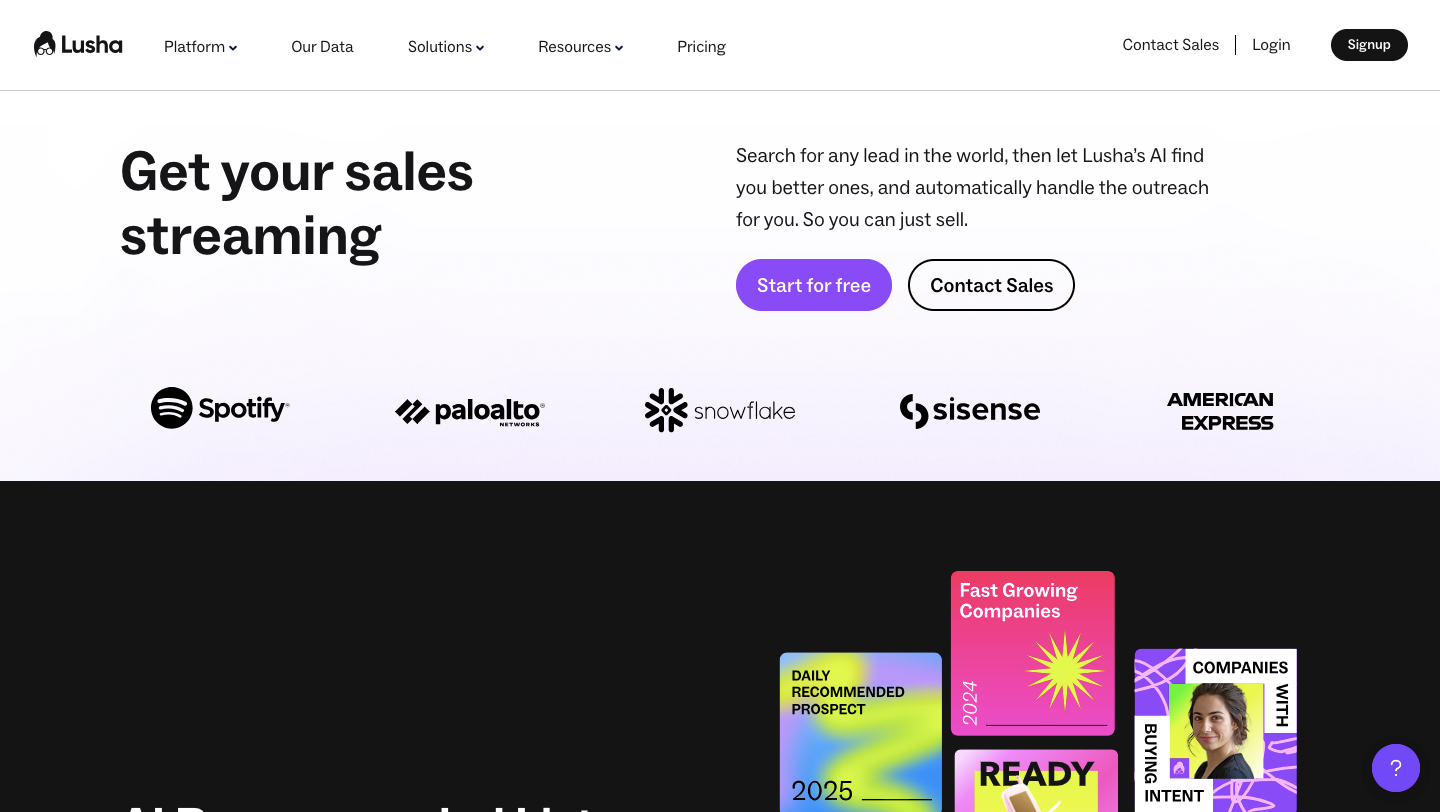
When you’re mid-prospecting and don’t want to leave your workflow, Lusha is a handy way to grab verified contact details. The browser extension makes it accessible right inside LinkedIn or a CRM. The limitation is volume — credit-based pricing can add up quickly once reps scale their outreach.
Key features
- Browser extension – Access verified phone numbers, emails, and firmographics instantly while browsing.
- Contact enrichment – Push updated records into your CRM or sales engagement tool in one click.
- Team dashboard – Manage usage and credits across your team.
Pricing
Lusha pricing is credit-based. Revealing an email costs 1 credit, while revealing a phone number costs 5 credits.
Where Lusha shines
- Real-time accessibility – Verified data without leaving your workflow.
- CRM-ready – Built to feed enriched contacts straight into Salesforce, HubSpot, and more.
Where Lusha falls short
- Niche industry gaps – Limited coverage in certain verticals like biotech or academia.
- Credit-based pricing – Can become costly for high-volume prospecting.
Customer reviews
“What I like best about Lusha is how easy it is to find contact details with just one click. It’s built right into LinkedIn and works smoothly in the background. Sometimes the contact information isn’t up to date or missing, especially for certain profiles. Also, the credit system can be a bit limiting if you’re doing a lot of outreach.” - Jithin M., verified G2 reviewer
Who Lusha is best for
- SDRs and AEs in tech-focused GTM teams.
- Outbound reps needing instant, verified contact data during daily prospecting.
Apollo.io: best sales prospecting tool for all-in-one outreach + contact data
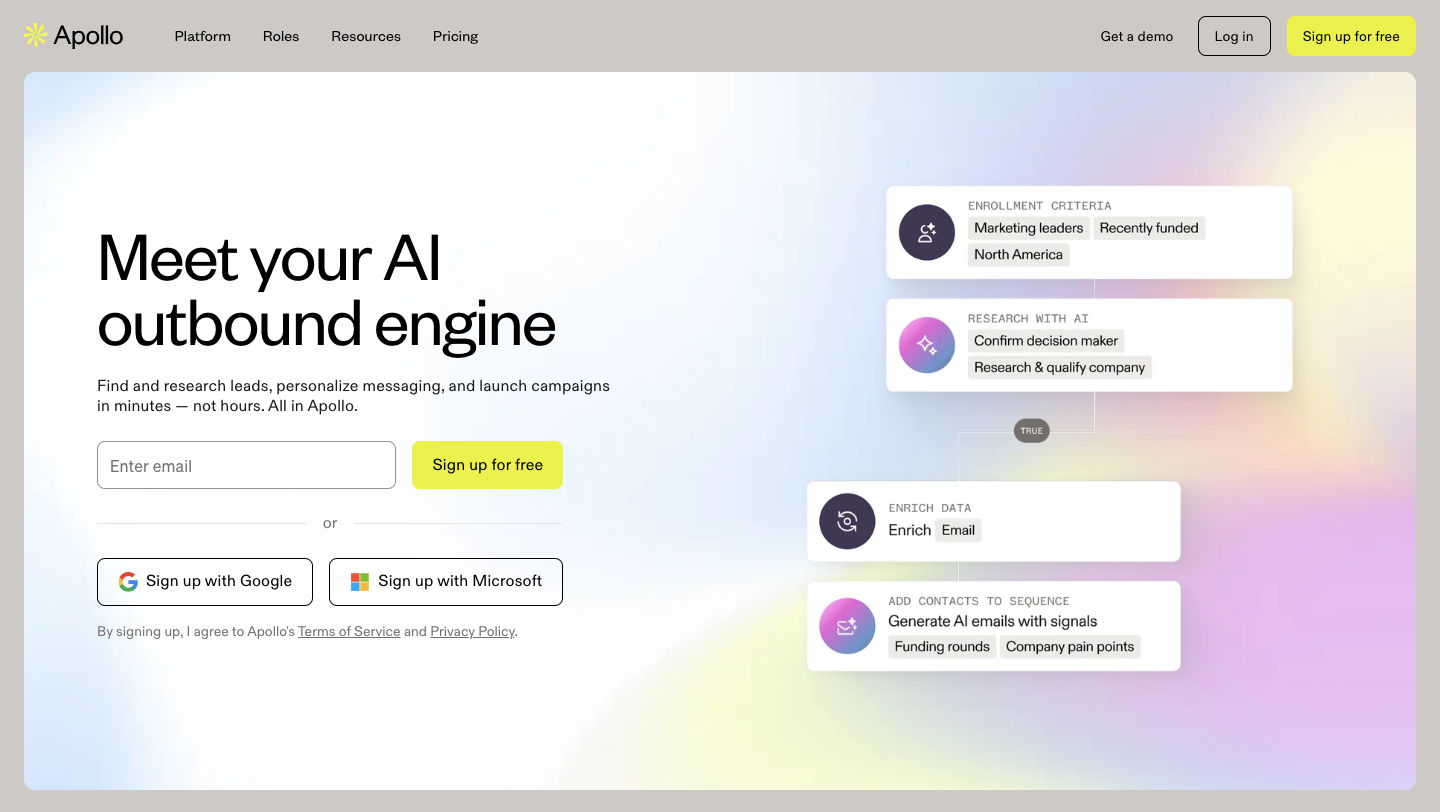
Apollo.io blends a large B2B contact database with multichannel outreach, giving smaller teams a single tool for prospecting and engagement.
Paid plans start at $59/user/month, with more advanced tiers up to $149.
It’s best for startups and mid-market GTM teams that want one system for discovery, sequencing, and engagement without buying multiple platforms.
Cognism: best sales prospecting tool for GDPR-compliant global data
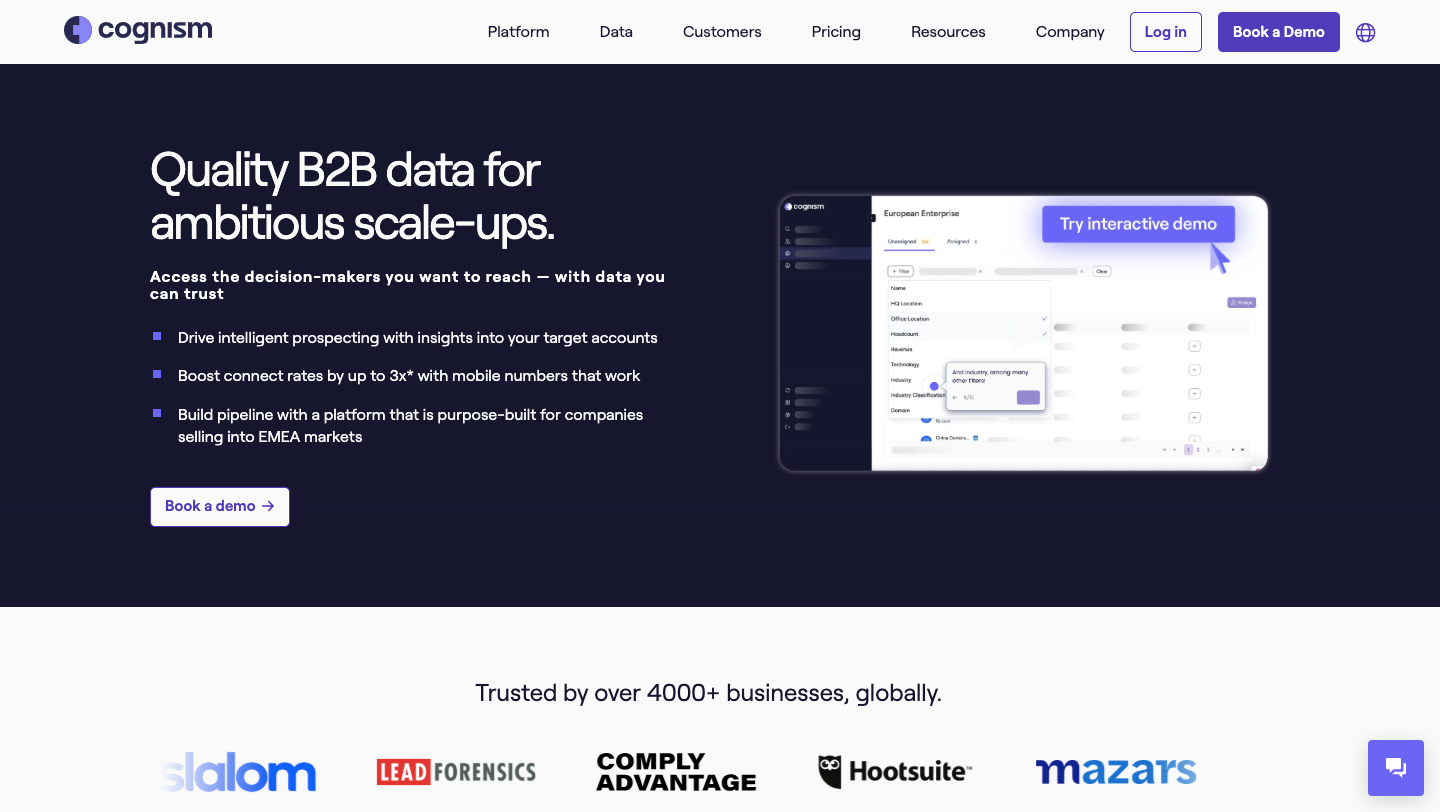
Cognism specializes in verified mobile and direct dial data outside the U.S., with GDPR and CCPA compliance at the core.
Pricing is custom, with packages tailored to region and volume.
It’s best suited for enterprise sales teams targeting EMEA or regulated industries like finance or healthcare, where compliance and global coverage matter more than U.S.-first scale.
Clay: best sales prospecting tool for no-code lead enrichment workflows
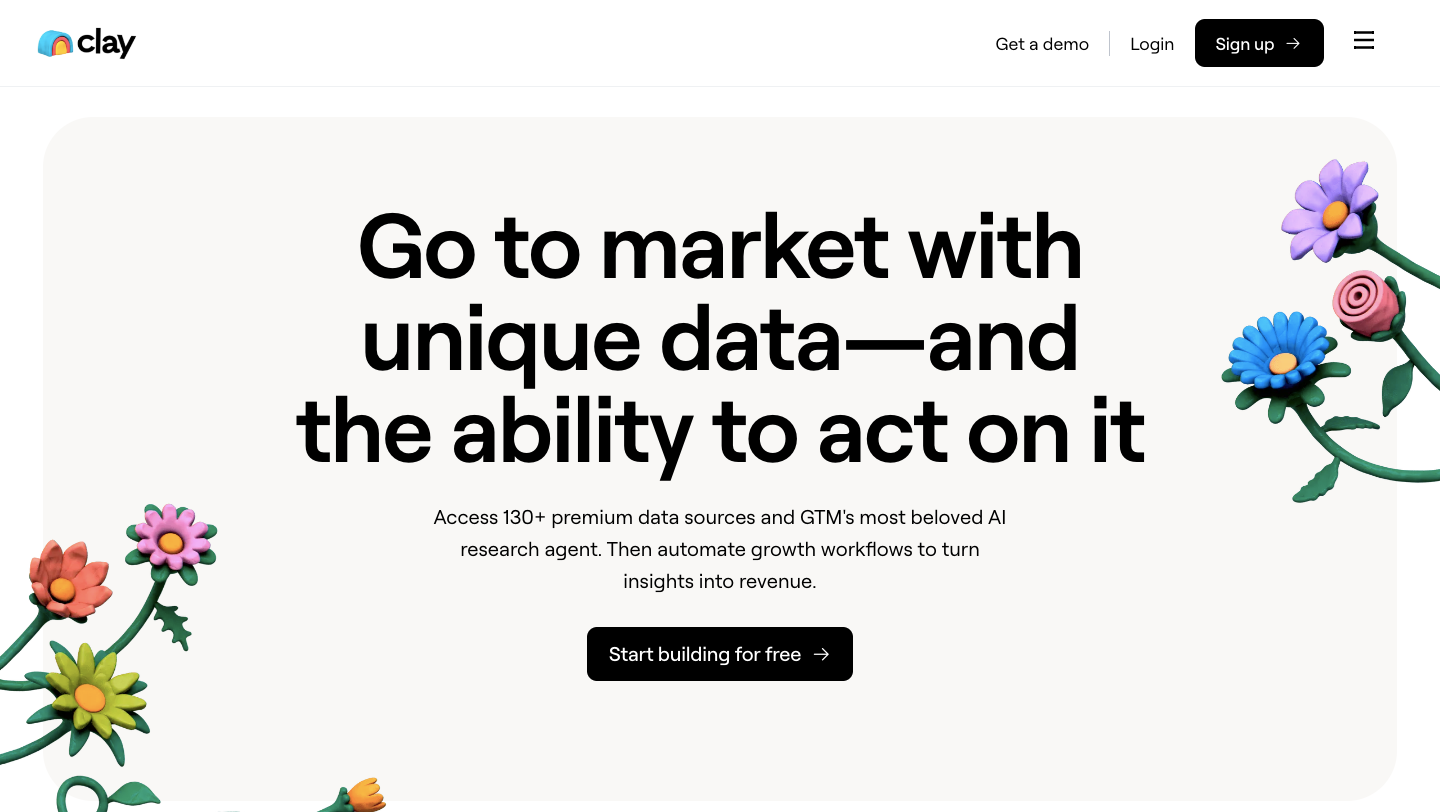
Clay turns static prospect lists into dynamic lead pipelines by connecting to 50+ data sources with conditional logic.
Paid plans start at $149/month, scaling to $800 and above for heavy use.
It’s best for RevOps or ops-minded GTM leaders who want flexible enrichment and scoring workflows without developer involvement, though it doesn’t handle outreach directly.
LeadIQ: best sales prospecting tool for LinkedIn lead capture + CRM sync

LeadIQ removes the copy-paste grind by capturing prospect data from LinkedIn and pushing it into your CRM in real time.
A free plan exists, while paid tiers start at $20/month.
It’s best for SDRs who spend most of their day on LinkedIn and want faster capture with less manual entry, but it won’t replace a sequencing or data provider.
Reply.io: best sales prospecting tool for multichannel outbound sequences

Reply.io gives SDR teams one place to run email, LinkedIn, SMS, and call sequences at scale.
Pricing starts at $99/user/month, with higher-volume email and AI-driven plans above that.
It’s best for outbound-focused teams that already have reliable data and want to orchestrate touchpoints across multiple channels without juggling separate tools.
Snov.io: best all-in-one outreach tool for lean sales teams

Snov.io combines email finding, verification, and drip campaigns in a single platform.
Plans start at $39/month, scaling with credits and recipients.
It’s best for startups or solo SDRs who need affordable list building and outreach in one place, but it doesn’t scale well for very large teams or LinkedIn/phone outreach.
SalesIntel: best sales prospecting tool for intent-driven targeting
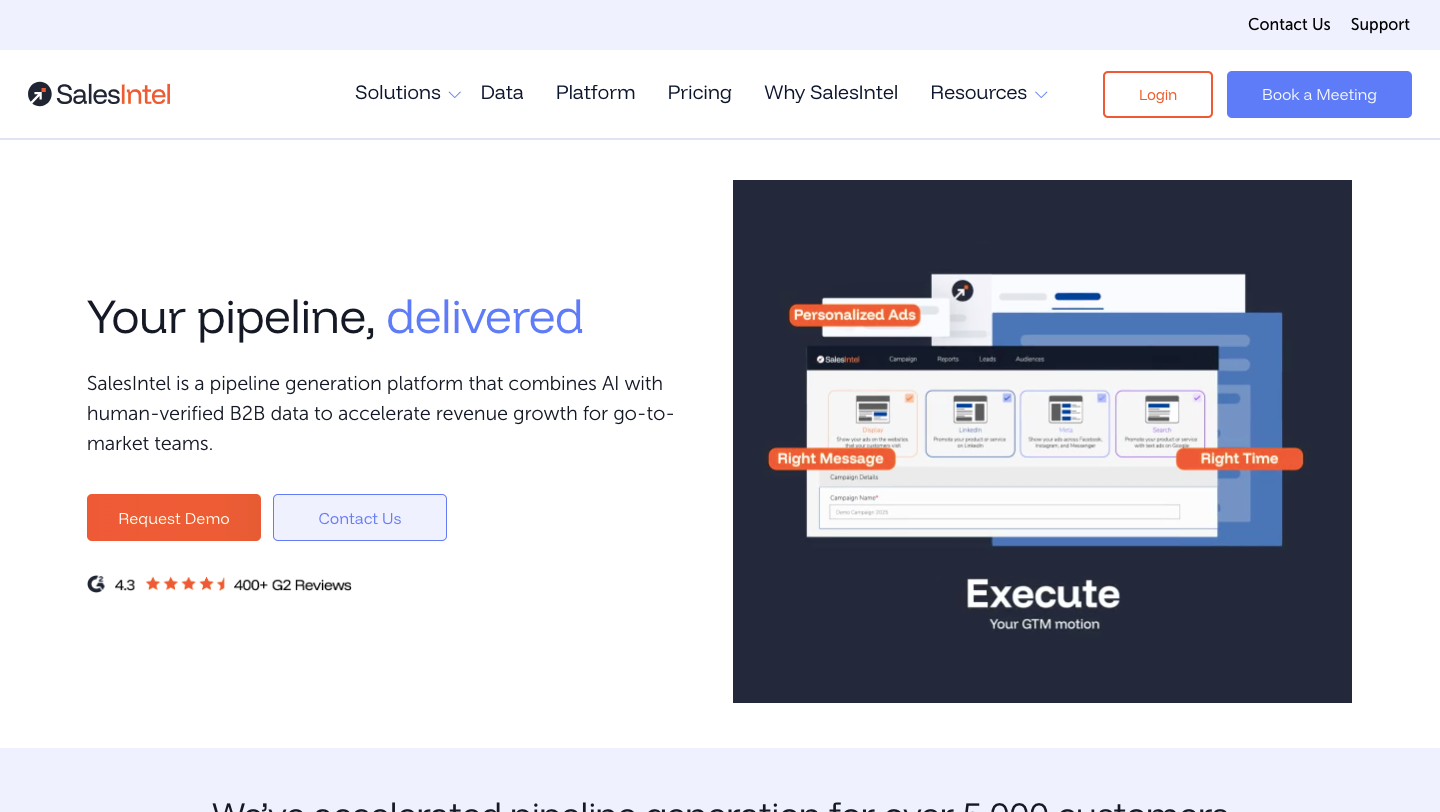
SalesIntel layers Bombora-powered intent data on top of human-verified B2B contacts.
Pricing is custom, with unlimited users and enrichment credits available on tailored plans.
It’s best for RevOps and ABM teams that prioritize targeting accounts already in-market, especially in U.S. campaigns, though international reach is limited compared to global-first providers.
Seamless.ai: best sales prospecting tool for real-time AI contact discovery

Seamless.ai scrapes the web in real time to deliver fresh contact data.
A free tier is available, with Pro and Enterprise plans on custom pricing.
It’s best for SDR teams that value daily lead volume and speed over strict accuracy — though without proper hygiene checks, CRM noise and duplicates can creep in.
Close: best sales prospecting tool for CRM + outreach in one
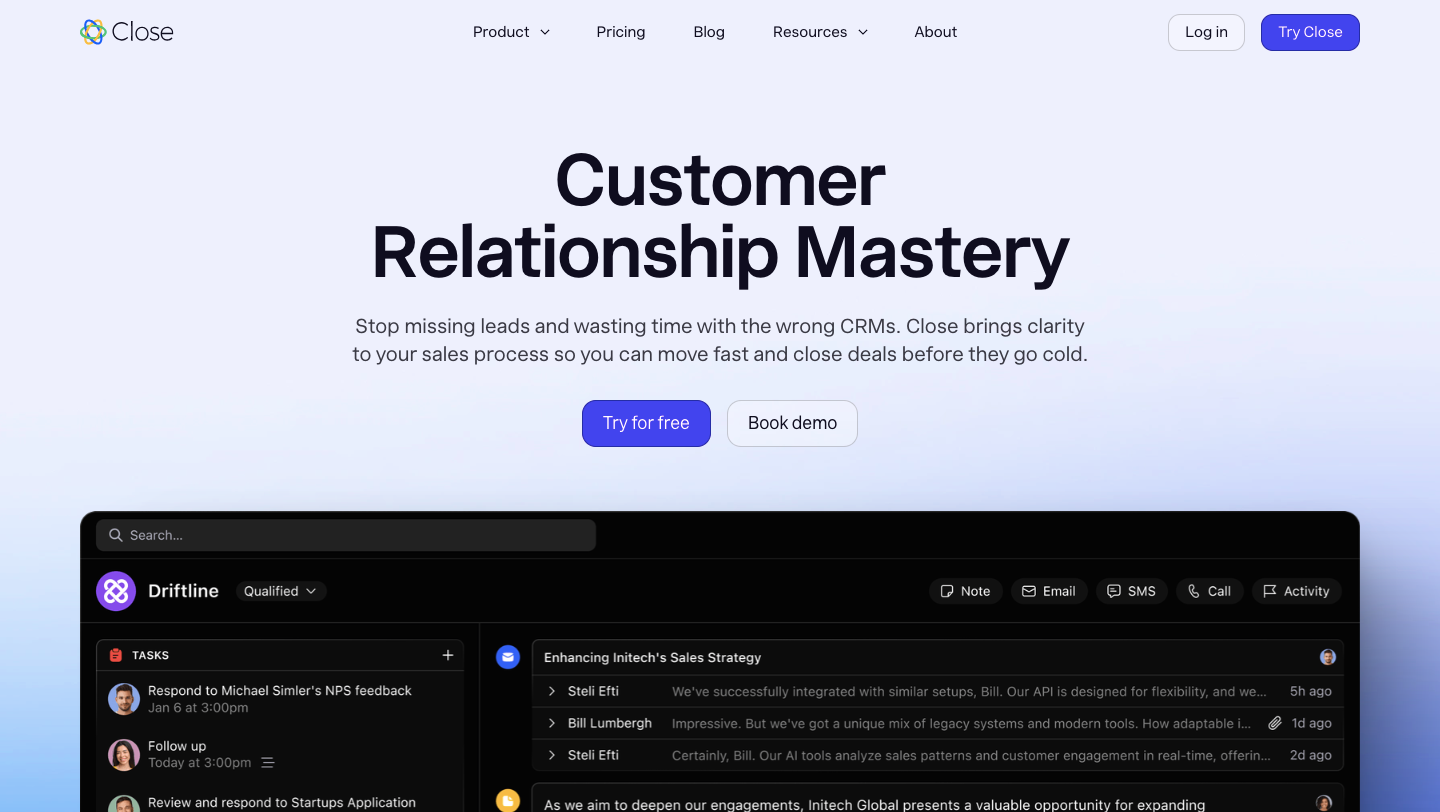
Close combines pipeline management with built-in calling, SMS, and email automation.
Pricing starts at $49/seat/month, with more advanced tiers at $109 and $149.
It’s best for SMB and mid-market sales teams that want CRM and outreach in one system, though it lacks enrichment and enterprise-level customization.
UpLead: best sales prospecting tool for verified B2B contact accuracy

UpLead emphasizes deliverability with real-time email verification and a 95% accuracy guarantee.
Paid plans begin at $99/month, with a 7-day free trial available.
It’s best for GTM teams that value data quality and clean CRM hygiene over raw volume, particularly those who want fewer bounces and more compliant outreach.
What to look for when choosing sales prospecting software
The best sales prospecting tools do more than collect leads — they qualify, route, and connect them to reps faster. Here’s what to prioritize:
Automated lead routing and qualification

Your tool should route leads instantly based on firmographics, behavior, or enrichment results. Default’s sales workflow builder lets you do this in real time without engineering.
Real-time enrichment + data hygiene
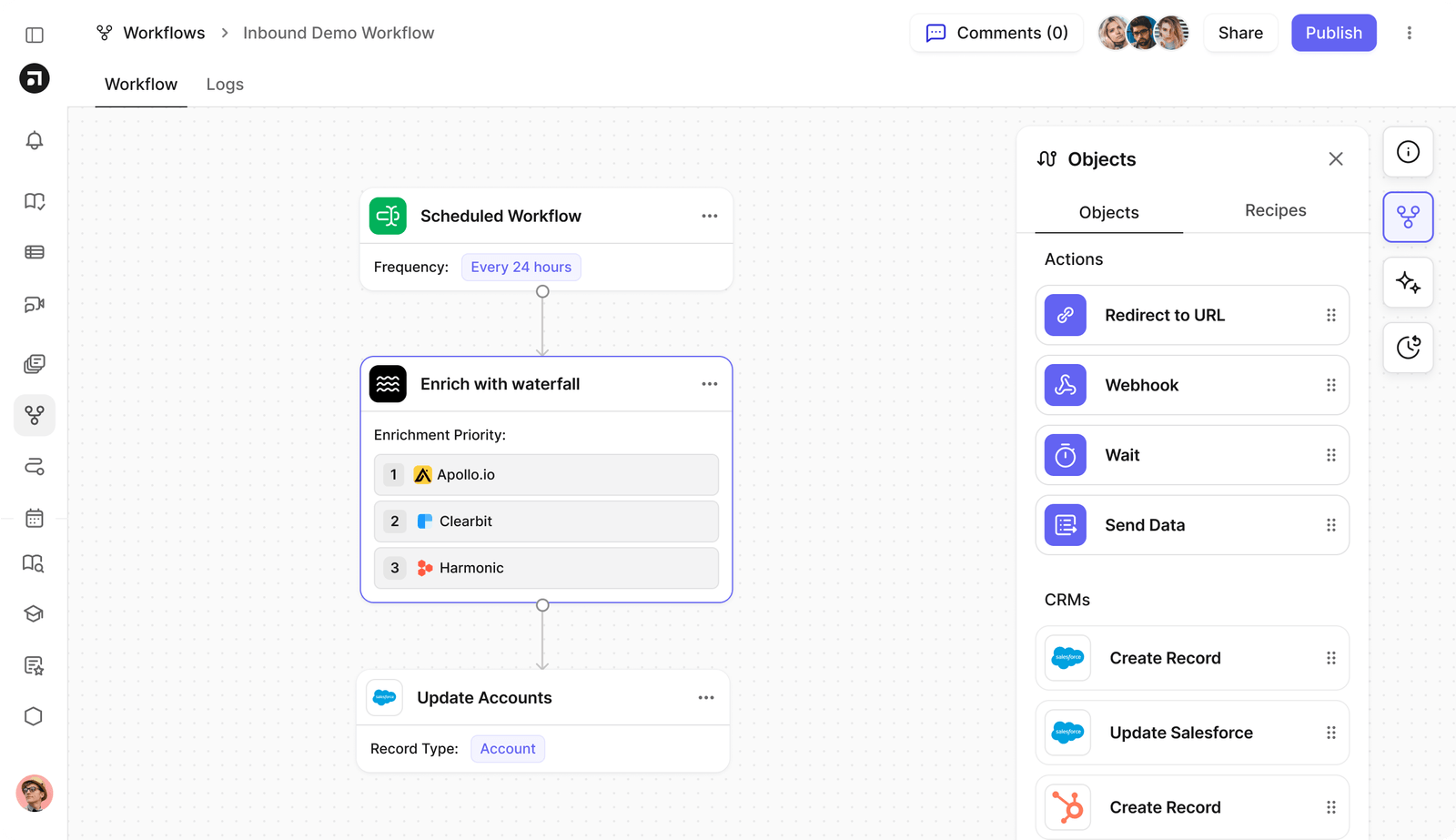
Continuous lead enrichment and de-duplication keep your CRM clean and reps focused on high-quality leads. Default’s enrichment waterfalls handle both at the point of entry.
Integrated scheduling + rep handoff

Let prospects book instantly while ensuring they’re matched to the right rep. Default’s built-in scheduler makes booking part of the routing process.
Types of sales prospecting tools
Not every team needs the same kind of prospecting software. The right tool depends on whether your motion is outbound, inbound, or somewhere in between. Here’s how the main categories break down:
- Contact data platforms – Best when outbound is your main motion and volume matters. These provide verified emails, phone numbers, and firmographics at scale. Ie, ZoomInfo, Apollo, UpLead, Cognism.
- Intent + enrichment platforms – Built for inbound-heavy teams that need to score, enrich, and route leads in real time. Ie. SalesIntel, Default.
- Outreach and sequencing tools – Useful when you already have good data but need to automate touches across multiple channels. Ie. Reply.io, Close, Snov.io.
- LinkedIn and browser-based scrapers – Handy for SDRs working inside LinkedIn or company sites who want fast, verified contact capture. Ie. LeadIQ, Lusha.
The best-fit category often depends on your sales motion: outbound-heavy teams lean on data platforms, inbound teams need enrichment and routing, and hybrid teams combine sequencing with fast contact capture.
Benefits of sales prospecting tools
Choosing the right prospecting software isn’t just about convenience — it changes how your revenue engine performs. Here’s what strong platforms deliver when they’re set up well:
Faster lead response = higher conversion
Every minute a lead sits unengaged, conversion rates drop. Tools that automate routing and qualification reduce response times from hours to seconds. That speed doesn’t just impress buyers — it directly translates to more meetings booked and higher pipeline velocity.
Cleaner CRM data = fewer wasted cycles
Dirty data is a silent killer of sales productivity. Duplicate records, missing fields, and inaccurate contact info force reps to chase dead ends. Prospecting tools with built-in enrichment and deduplication keep CRMs clean at the point of entry, so reps only work high-quality leads.
Personalization at scale = better engagement
Prospects can spot a generic email instantly. Enrichment and segmentation allow reps to personalize messages at volume, referencing firmographics, intent signals, or recent activity. The result: outreach that feels relevant, not automated — and response rates that reflect it.
Sharper targeting = more efficient spend
Without intent or enrichment, teams waste ad budgets and SDR time on accounts that were never going to convert. Prospecting platforms narrow the focus to ICP-matched and in-market buyers, which means more efficient campaigns and shorter deal cycles.
Higher rep productivity = more selling hours
Sales reps often spend more time updating records than talking to prospects. By automating research, enrichment, and admin tasks, prospecting tools free up hours each week. That extra selling time compounds across a team, often making the difference between hitting and missing quota.
More predictable pipeline = stronger forecasting
Inconsistent qualification creates rollercoaster pipelines. With automated enrichment, scoring, and routing in place, the quality of pipeline data improves — giving RevOps leaders more reliable forecasting. Instead of guessing, leaders can plan hiring, territory coverage, and spend based on clean data.
Better cross-team alignment = fewer missed opportunities
Marketing, sales, and RevOps often lose leads in the handoff. Tools that centralize enrichment and routing close those gaps, making sure every lead gets to the right person without delay. That alignment reduces friction across teams and ensures no revenue opportunity goes begging.
Clean data, precise targeting, and instant routing turn messy processes into predictable growth. For GTM leaders, that means shorter deal cycles, stronger forecasts, and more time spent on conversations that actually convert.
Overcome sales prospecting challenges with Default software
Most prospecting tools solve a piece of the puzzle — one provides data, another sequences outreach, a third tries to keep the CRM clean. The result is a stack that’s busy instead of productive, with reps still losing deals to delays and bad handoffs.
Default takes a different approach.
It consolidates enrichment, routing, scheduling, and CRM automation into one inbound orchestration platform — cutting handoff delays, cleaning data at the source, and giving full visibility into every lead.
For RevOps and demand gen leaders, that means fewer tools to manage, faster pipeline creation, and more predictable conversion rates.
Book a demo with Default today and see how inbound prospecting should really work.
Sales prospecting software FAQs
How accurate is the contact data from sales prospecting tools?
Accuracy varies widely. Top platforms that rely on human verification or real-time enrichment typically reach 85–95%. Always look for bounce-rate guarantees or intent overlays — those are the signs you’re paying for quality, not just volume.
How often should I clean and update my prospect lists?
Outbound teams should plan for at least a quarterly cleanup. Inbound-heavy teams are better served automating hygiene at the point of entry with enrichment waterfalls. The sooner bad data is caught, the less it costs you in wasted touches.
How can I avoid outdated contact info?
Prioritize tools that verify and enrich records in real time rather than static exports. Platforms like Default and UpLead validate at the moment of capture, keeping your CRM from filling up with stale leads.
Will sales prospecting tools integrate with my CRM?
Most modern tools plug into Salesforce, HubSpot, or your engagement platform. The difference is how seamless the sync is. Default pushes enriched, routed, and scheduled leads directly into your CRM without manual handoffs — removing one of the biggest points of failure in the process.
Conclusion

Former pro Olympic athlete turned growth marketer! Previously worked at Chili Piper and co-founded my own company before joining Default two years ago.
Accelerate your growth with Default.
Revamp inbound with easier routing, actionable intent, and faster scheduling















.png)


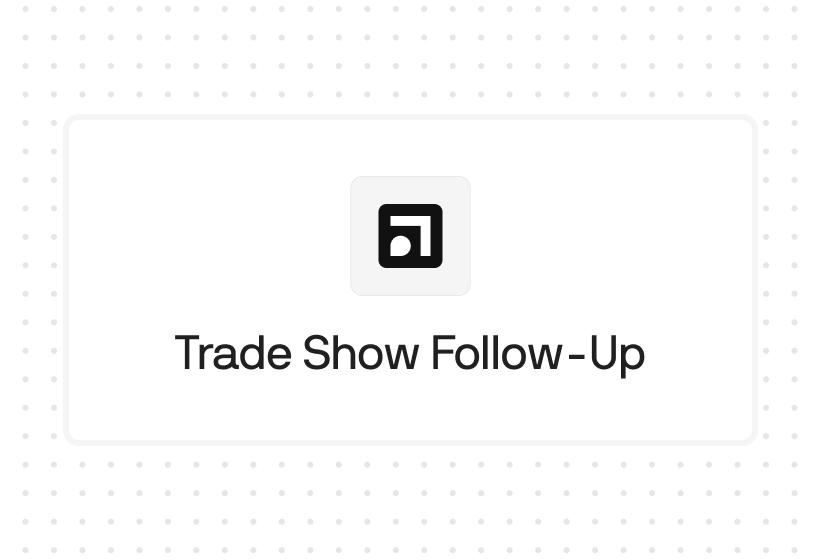
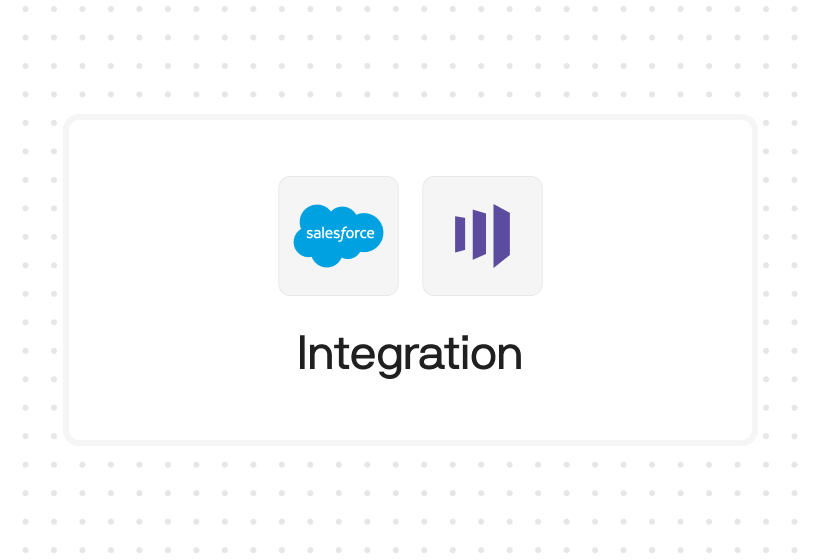




%201.svg)



.svg)





%201.svg)



%201.svg)

